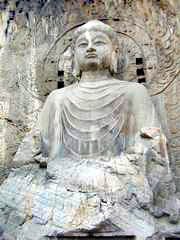The Longmen Grottoes
 The world-famous Longmen Grottoes are located 12km south of Luoyang. Here two mountains, namely, East Hill (Mt. Xiangshan) and West Hill (Mt. Longmen), confront each other with the Yi River traversing northward between them, just like a pair of Chinese gate towers. So during the Zhou and Qin dynasties, it was called "Yi Que" (Gate of Yi River). Later, when the Sui established its capital city in Luoyang, the palace gate was just facing Yi Que, hence the name "Longmen" which means "Dragon Gate".
The world-famous Longmen Grottoes are located 12km south of Luoyang. Here two mountains, namely, East Hill (Mt. Xiangshan) and West Hill (Mt. Longmen), confront each other with the Yi River traversing northward between them, just like a pair of Chinese gate towers. So during the Zhou and Qin dynasties, it was called "Yi Que" (Gate of Yi River). Later, when the Sui established its capital city in Luoyang, the palace gate was just facing Yi Que, hence the name "Longmen" which means "Dragon Gate".
Spanning a length of over 1,000 meters on the hillsides along the Yi River, the Longmen Grottoes, together with the Mogao Caves in Dunhuang (Gansu Province) and the Yungang Grottoes (Shanxi Province), are reputed as the three greatest stone sculpture treasure houses in China. In the year 2000, Longmen Grottoes was listed by UNESCO as a World Cultural Heritage Site.
The Longmen Grottoes were first sculptured and chiseled around 493AD when the capital of the Northern Wei Dynasty (386-534) was moved from Datong to Luoyang. The entire construction of Longmen Grottoes lasted more than four hundred years through the Northern Dynasties, Sui Dynasty, Tang Dynasty and up to Song Dynasty. Today, there are still 2345 caves and niches, 100,000 Buddhist images ranging in size from 2 cm to 17.14 meters, more than 2800 inscribed tablets, and 43 Buddhist pagodas remaining in both East Hill and West Hill. Altogether 30 % date from Northern Wei Dynasty, 60 % from Tang Dynasty and the rest 10 % from other periods.
Masterpieces of Longmen Grottoes
Fengxian Temple Stretching along the precipitous cliff of the southern side of West Hill, Fengxian Temple, also named Grand Vairocana Buddha Niche, is the largest cave in Longmen. Measuring 35 meters in width and 39 meters in length, this cave was carved over 1300 years ago (from 672 to 675 AD) during the Tang Dynasty. When it was first constructed, the entire grotto was covered with a roof and enclosed from the natural elements. Today the roof is missing and the sculptures stand out in the open air.The most extraordinary statue in Fengxian Temple is the Grand Vairocana Buddha, which is 17.14 meters tall with his head 4 meters long and his ear 1.9 meters wide. Sitting in the middle of the niche, this colossal Buddha shows a perfect combination of moral integrity, delicate emotions, broad mind and elegant semblance. Her lips are slightly upturned and her head a little bit lowered, a slight smile makes her look like a sagacious and benign middle-aged woman whom you would respect but not fear.
Guyang Cave Guyang Cave, sculpted between 495 and 575 AD, is regarded as the earliest of the Longmen Grottoes. Based on a natural limestone cave, this cave is the most important cave in the series and represents the highest skill of carving, rock painting, and architecture of the Northern Wei.
Lianhua Cave This cave was so named because there is a large and beautiful lotus flower on its ceiling.
This cave was dug out about 527 AD in the late period of the Northern Wei Dynasty. A statue of Sakyamuni, as the chief Buddha, is enshrined in this cave. Adopting a standing position, this statue is 5.1 meters high and has the face and one forearm showing damage.In this cave there are also numerous niches decorated with fine carvings of colorful strings, clouds, lotus flowers, geometrical patterns etc. Upon the cave ceiling there is a large lotus flower surrounded by figures of Apsaras in relief, which are slim, graceful and vivid. This cave is named in honor of this lovely flower.













No comments:
Post a Comment